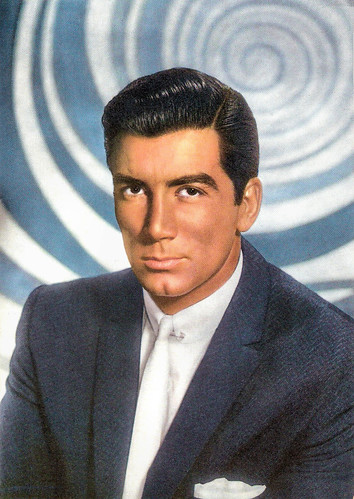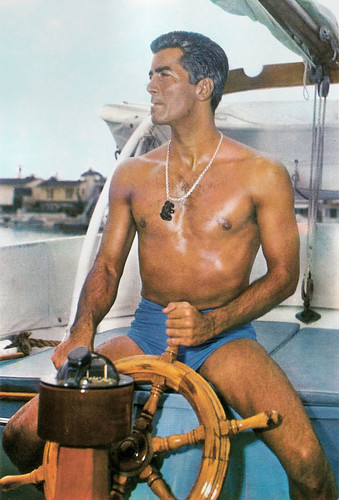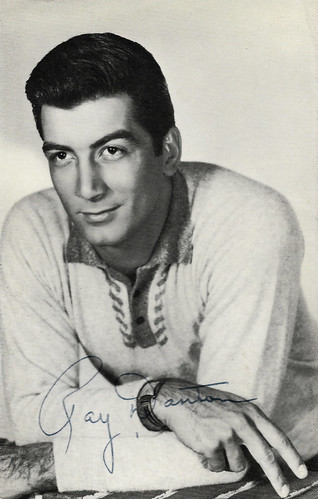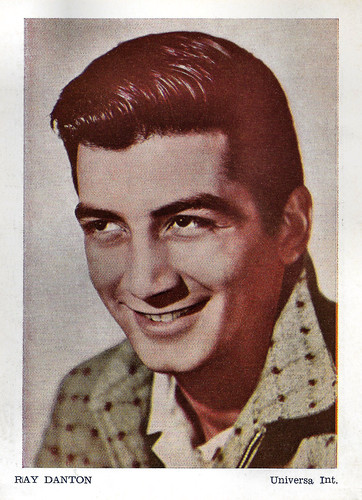American actor Ray Danton (1931-1992) was a handsome and smooth-natured leading man who often played oily individuals in Hollywood films and TV series. He also worked in Europe where he directed some films too.

Italian postcard by Rotalcolor, Milano, no. N. 139.

Spanish postcard by Raker, no. 1126.
Ray Danton was born Raymond Caplan in New York in 1931. Raymond was the son of Myrtle (née Menkin) and Jack Caplan. Danton entered show business as a child radio actor on NBC radio's Let's Pretend show in 1943.
Danton did many stage roles whilst attending the University of Pittsburgh. He was dramatically trained at Carnegie Tech and in 1950 went to London to appear on stage in the Tyrone Power production Mister Roberts. Danton's acting career was put on hold when he served in the United States Army infantry during the Korean War from 1951–1954. His on-screen debut was as a moody Native American opposite Victor Mature in Chief Crazy Horse (George Sherman, 1955), a biography of the famous Lakota Sioux war chief told entirely from the Indian viewpoint. He was contracted to Universal Pictures.
He next played a supporting part as a smooth but dangerous villain in I'll Cry Tomorrow (Daniel Mann, 1955) starring Susan Hayward. For this part, he won the Golden Globe as Most Promising Newcomer. On the set of his third film for Universal The Looters (Abner Biberman, 1955) he met his future wife Julie Adams. Danton guest-starred in many 1950s TV shows including Playhouse 90 (1956), Wagon Train (1957), and 77 Sunset Strip (1958), often as a gunslinger or a slippery criminal.
Danton found plenty of demand for his talents and appeared in several minor films including the Film Noir The Night Runner (Abner Biberman,1957), the war film Tarawa Beachhead (Paul Wendkos, 1958), in which he starred with his wife, Julie Adams, and then as a serial rapist in The Beat Generation (Charles F. Haas, 1959) opposite Steve Cochran and Mamie van Doren.
However, his most well-remembered role was as the vicious prohibition gangster Jack Diamond in The Rise and Fall of Legs Diamond (1960) also starring a young Warren Oates and directed by Budd Boetticher. Wikipedia: "Danton played his role using dynamic body language with his smooth persona fitting the character like a glove." Danton reprised his Legs Diamond role only a year later in the unrelated, and not as enjoyable Portrait of a Mobster (Joseph Pevney, 1961).

British postcard in the Celebrity Autograph Series by Celebrity Publishers LTD., London, no. 2789. Photo: Universal-International. Publicity still for The Night Runner (Abner Biberman, 1957).

Belgian collectors card by Merbotex, Bruxelles. Photo: Universal Int.
Cornering the market on playing shady characters, Ray Danton then portrayed troubled actor George Raft in The George Raft Story (Joseph M. Newman, 1961) with Jayne Mansfield. Still, he was back on the side of good in 1962 playing an Allied officer at the invasion of Normandy in The Longest Day (Ken Annakin, Andrew Marton, Bernhard Wicki, 1962).
Europe then beckoned for the virile Danton, and like many other young US actors in the early 1960s, he made several films in Italy and Spain between 1964 and 1969 with a mixture of success. These films included Sandokan alla riscossa/Sandokan Fights Back (Luigi Capuano, 1964) with Guy Madison, and the Eurospy films Corrida pour un espion/Code Name: Jaguar (Maurice Labro, 1965) with Pascale Petit, and New York chiama Superdrago/Secret Agent Super Dragon (Giorgio Ferroni, 1966) with Marisa Mell and Margaret Lee.
Danton returned to the USA in the early 1970s and ran his own production company in Barcelona, Spain. In Europe, he directed the AIP production of Deathmaster (Ray Danton, 1972) starring Robert Quarry who was riding high on the success of the Count Yorga vampire films. Danton also co-directed La tumba de la isla maldita/Crypt of the Living Deads (Julio Salvador, Ray Danton, 1973) with Mark Damon.
Later he became involved in television and directed episodes of some of the most popular TV series of the 1970s and 1980s, including Quincy M.E. (1976), The Incredible Hulk (1978), Magnum, P.I. (1980), Dynasty (1981), and Cagney & Lacey (1981). His final directorial work was an episode for the TV series Mike Hammer (1989).
Ray Danton passed away in 1992 from kidney failure. He was only 61. He was divorced from his wife, Julie Adams, in 1978 (IMDb) or 1981 (Wikipedia). They had two sons, assistant director Steve Danton (1956) and editor Mitchell Danton (1962). His companion at the time of his death was actress Jeannie Austin, who was cast in a couple of TV episodes Ray directed, including Magnum, P.I. (1980).
Trailer for The George Raft Story (Joseph M. Newman, 1961). Source: horrormovieshows (YouTube).
Sources: Wikipedia and IMDb.
This post was last updated on 24 November 2023.

Italian postcard by Rotalcolor, Milano, no. N. 139.

Spanish postcard by Raker, no. 1126.
A smooth but dangerous villain
Ray Danton was born Raymond Caplan in New York in 1931. Raymond was the son of Myrtle (née Menkin) and Jack Caplan. Danton entered show business as a child radio actor on NBC radio's Let's Pretend show in 1943.
Danton did many stage roles whilst attending the University of Pittsburgh. He was dramatically trained at Carnegie Tech and in 1950 went to London to appear on stage in the Tyrone Power production Mister Roberts. Danton's acting career was put on hold when he served in the United States Army infantry during the Korean War from 1951–1954. His on-screen debut was as a moody Native American opposite Victor Mature in Chief Crazy Horse (George Sherman, 1955), a biography of the famous Lakota Sioux war chief told entirely from the Indian viewpoint. He was contracted to Universal Pictures.
He next played a supporting part as a smooth but dangerous villain in I'll Cry Tomorrow (Daniel Mann, 1955) starring Susan Hayward. For this part, he won the Golden Globe as Most Promising Newcomer. On the set of his third film for Universal The Looters (Abner Biberman, 1955) he met his future wife Julie Adams. Danton guest-starred in many 1950s TV shows including Playhouse 90 (1956), Wagon Train (1957), and 77 Sunset Strip (1958), often as a gunslinger or a slippery criminal.
Danton found plenty of demand for his talents and appeared in several minor films including the Film Noir The Night Runner (Abner Biberman,1957), the war film Tarawa Beachhead (Paul Wendkos, 1958), in which he starred with his wife, Julie Adams, and then as a serial rapist in The Beat Generation (Charles F. Haas, 1959) opposite Steve Cochran and Mamie van Doren.
However, his most well-remembered role was as the vicious prohibition gangster Jack Diamond in The Rise and Fall of Legs Diamond (1960) also starring a young Warren Oates and directed by Budd Boetticher. Wikipedia: "Danton played his role using dynamic body language with his smooth persona fitting the character like a glove." Danton reprised his Legs Diamond role only a year later in the unrelated, and not as enjoyable Portrait of a Mobster (Joseph Pevney, 1961).

British postcard in the Celebrity Autograph Series by Celebrity Publishers LTD., London, no. 2789. Photo: Universal-International. Publicity still for The Night Runner (Abner Biberman, 1957).

Belgian collectors card by Merbotex, Bruxelles. Photo: Universal Int.
Europe beckoned
Cornering the market on playing shady characters, Ray Danton then portrayed troubled actor George Raft in The George Raft Story (Joseph M. Newman, 1961) with Jayne Mansfield. Still, he was back on the side of good in 1962 playing an Allied officer at the invasion of Normandy in The Longest Day (Ken Annakin, Andrew Marton, Bernhard Wicki, 1962).
Europe then beckoned for the virile Danton, and like many other young US actors in the early 1960s, he made several films in Italy and Spain between 1964 and 1969 with a mixture of success. These films included Sandokan alla riscossa/Sandokan Fights Back (Luigi Capuano, 1964) with Guy Madison, and the Eurospy films Corrida pour un espion/Code Name: Jaguar (Maurice Labro, 1965) with Pascale Petit, and New York chiama Superdrago/Secret Agent Super Dragon (Giorgio Ferroni, 1966) with Marisa Mell and Margaret Lee.
Danton returned to the USA in the early 1970s and ran his own production company in Barcelona, Spain. In Europe, he directed the AIP production of Deathmaster (Ray Danton, 1972) starring Robert Quarry who was riding high on the success of the Count Yorga vampire films. Danton also co-directed La tumba de la isla maldita/Crypt of the Living Deads (Julio Salvador, Ray Danton, 1973) with Mark Damon.
Later he became involved in television and directed episodes of some of the most popular TV series of the 1970s and 1980s, including Quincy M.E. (1976), The Incredible Hulk (1978), Magnum, P.I. (1980), Dynasty (1981), and Cagney & Lacey (1981). His final directorial work was an episode for the TV series Mike Hammer (1989).
Ray Danton passed away in 1992 from kidney failure. He was only 61. He was divorced from his wife, Julie Adams, in 1978 (IMDb) or 1981 (Wikipedia). They had two sons, assistant director Steve Danton (1956) and editor Mitchell Danton (1962). His companion at the time of his death was actress Jeannie Austin, who was cast in a couple of TV episodes Ray directed, including Magnum, P.I. (1980).
Trailer for The George Raft Story (Joseph M. Newman, 1961). Source: horrormovieshows (YouTube).
Sources: Wikipedia and IMDb.
This post was last updated on 24 November 2023.
No comments:
Post a Comment